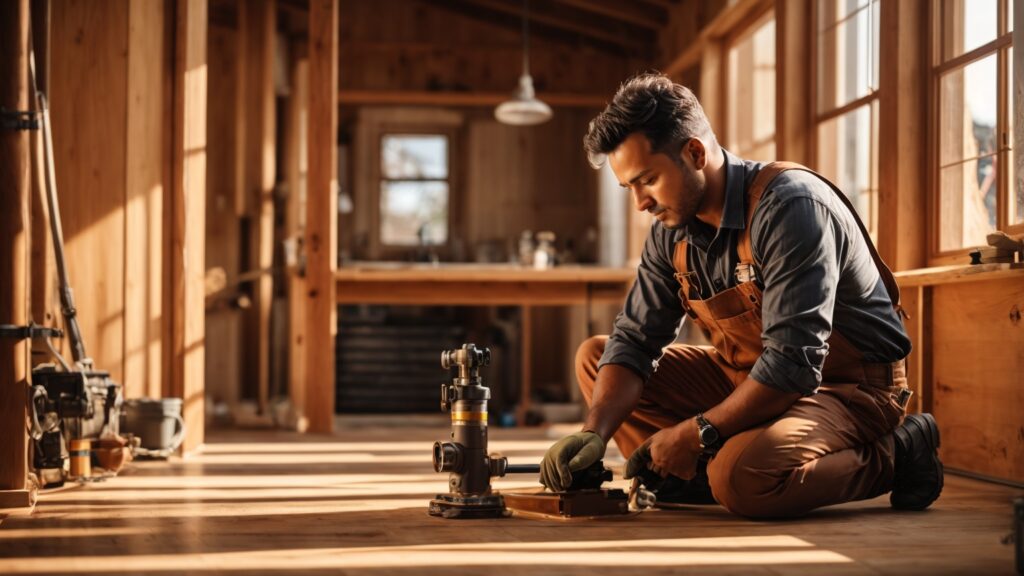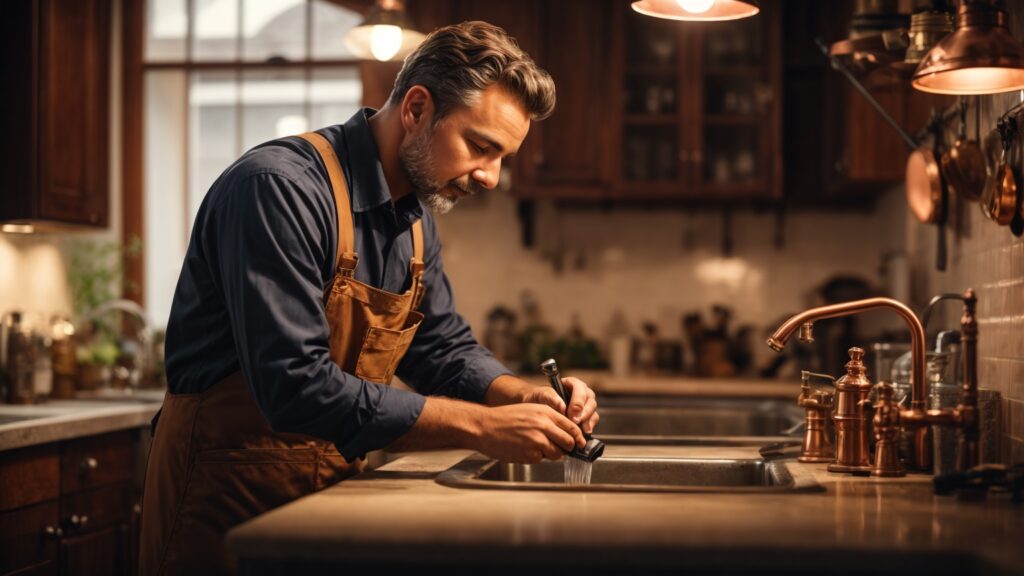Estimated reading time: 13 minutes
Introduction
When tackling how to replumb a house, it’s critical to grasp the key elements involved. This project, vital for improving your home’s plumbing efficiency and lifespan, entails swapping old or faulty pipes for new, durable alternatives like PEX. For homeowners, being informed about the advantages of replumbing with PEX, the expected timeframe and steps involved, and cost considerations lays a solid foundation for this major home upgrade. Understanding the process and what to anticipate during replumbing, along with advice for avoiding common errors such as damaging drywall, is also important. The decision between DIY replumbing versus hiring a professional hinges on several aspects, including the project’s complexity and your familiarity with home improvements.
At the core of this effort is the material selection—PEX, copper, or CPVC—each offering its own set of benefits in terms of cost, durability, and ease of installation. Moreover, getting your home ready for this significant task is crucial, encompassing securing the right plumbing services to address potential plumbing issues, like lead pipes, sediment, and discolored water. The necessity for a plumbing contractor becomes apparent, especially when undertaking extensive remodels or when the time to repipe coincides with a larger renovation effort. For those seeking everything you need to know about repiping, including identifying the appropriate time to repipe or the details of repiping your house, becoming informed is the initial step. This includes insights into plumbing fixtures, the potential necessity to cut into walls or floors, and ensuring the safety of your drinking water remains uncompromised.
Key TakeAway
- Benefits of replumbing with PEX.
- Timeframe and steps involved in replumbing a house.
- Cost considerations and how to use a repiping cost calculator.
- Understanding the process and what to expect during replumbing.
- Tips on avoiding common mistakes, like damaging drywall.
- DIY replumbing vs. hiring a professional.
Understanding the Replumbing Process
Grasping the replumbing process is crucial for homeowners contemplating repiping a house. Undertaking a repipe a house project is a significant enhancement, involving the removal of old pipes and the installation of new ones to ensure an efficient and dependable plumbing system. It’s important to know about repiping a house, which includes understanding the steps from evaluating the existing system to installing and testing new pipes. Often, there’s a need to cut through walls or floors, necessitating meticulous planning and precision to keep damage and subsequent repair costs low. Although this task is complex, it can markedly improve water quality and pressure, representing a valuable investment in the longevity and functionality of your home’s plumbing system.
Steps in the Replumbing Process
- Assessing the Current Plumbing System: Examine the existing pipes for wear, damage, and material type.
- Creating a Replumbing Plan: Determine the scope of work, including which pipes need replacing and the best route for new pipes.
- Choosing the Right Materials: Selecting between options like PEX, copper, and CPVC, considering factors like cost, durability, and ease of installation.
- Gathering Tools and Materials: Collect all necessary tools and materials before beginning the work.
- Removing Old Pipes: Carefully remove existing pipes while minimizing damage to walls and floors.
- Installing New Pipes: Laying out and securing new pipes according to the plan.
- Testing the New System: Ensuring there are no leaks and that the system operates correctly.
PEX vs. Copper vs. CPVC: What’s Best for Your Home?
When choosing between PEX, copper pipes, and CPVC pipes for your repiping project, it’s important to know what to expect from the process. The task of repiping a home requires an assessment of the number of plumbing fixtures, the condition of old plumbing, and recognizing the need to repipe. Copper pipes are valued for their longevity, while CPVC pipes present an economical choice with straightforward installation. Nonetheless, PEX emerges as the preferred option for its adaptability and potential for saving money on repiping.
The need for repiping usually stems from problems such as poor water pressure or deteriorating old plumbing that compromises the water main and the entire system’s efficiency. Homeowners should consider repiping your house when constant plumbing repairs suggest that repiping may ultimately save money in the long run, guaranteeing a more efficient and less problematic system. Investing in repiping your home with the appropriate pipes in a home can offer significant advantages, enhancing both water quality and system dependability.
“When it comes to replumbing, the choice of materials makes a huge difference. PEX is often preferred for its cost-effectiveness and ease of installation, especially in residential settings.” – John Doe, Licensed Plumber
How Long Does It Take to Replumb a House?
The timeframe for the repiping process can take anywhere from a few days to a couple of weeks, depending primarily on the number of bathrooms, accessibility of pipes, and if the repipe a home effort is coupled with a major home remodel. Pipes may need assessment for their state, as pipes can corrode over time, particularly in residences using chlorinated polyvinyl chloride (CPVC), which is prone to corrosion. Updating to newer water pipes not only assures clean and safe water flow but can also influence the cost and efficiency of the household’s water filtration system.
The total cost of the undertaking includes the following: materials, labor, and any necessary upgrades or repairs to current systems. Additionally, getting an inspection before pipes are installed assists homeowners in understanding the scope of work required, ensuring new pipes can help enhance the efficiency and longevity of the overall plumbing system.
Steps to Prepare Your Home for Replumbing
Before replumbing begins, it’s essential to prepare your home. This includes clearing access to pipes, protecting furniture and floors from dust and debris, and planning for water shut-off during the project.
Replumbing a house is a significant undertaking that involves careful planning, selection of materials, and an understanding of the process. Choosing the right materials and preparing your home are crucial steps in ensuring a smooth replumbing project.

Cost Considerations to Replumb Your House
One of the critical aspects of replumbing a house is understanding and managing the costs involved. The expense of replumbing can vary widely based on factors like the size of your home, the type of pipes used, and whether you choose a DIY approach or hire professionals. Having a clear budget and understanding the factors that influence the overall cost is essential.
- Size and Layout of the House: Larger homes with more bathrooms and fixtures will cost more to replumb.
- Type of Piping Material: PEX, copper, and CPVC vary in price, with copper generally being the most expensive.
- Accessibility of Existing Pipes: More accessible pipes reduce labor costs.
- Labor Costs: Professional plumber rates can vary depending on the region and the job’s complexity.
- Additional Repairs: Costs can increase if there are other issues like water damage or mold.
Breaking Down the Material Costs: PEX, Copper, and CPVC
- PEX: Although affordable and versatile, PEX is often the most cost-effective choice.
- Copper: While durable and reliable, copper is more expensive, both in material and labor costs, due to its installation complexity.
- CPVC: A middle-ground option in terms of cost, CPVC is less expensive than copper but slightly more expensive than PEX.
Comparison of House Replumb Costs
| Material | Average Cost per Foot | Installation Complexity | Durability |
|---|---|---|---|
| PEX | $0.50 – $2 | Low | High |
| Copper | $2 – $4 | High | Very High |
| CPVC | $1 – $2 | Medium | Medium |
How a House Replumb Can Be a Cost-Effective Investment
While the upfront costs of replumbing can be significant, it’s important to consider the long-term savings. Upgraded plumbing reduces the risk of costly water damage repairs, improves water efficiency, and can enhance the resale value of your home.
Understanding the cost considerations is crucial when planning a replumbing project. Factors like the choice of material, house size, and labor costs significantly determine the overall expense. While the initial investment may be substantial, the long-term benefits and savings make replumbing a wise decision for many homeowners.
DIY vs Professional Replumbing: What You Need to Know
Deciding between a DIY replumbing project and hiring a professional is a crucial choice for homeowners. Each option has pros and cons, ranging from cost savings to the complexity of work. Understanding these differences helps make an informed decision that aligns with your skills, budget, and the project’s requirements.
Case Study: John and Jane Doe’s DIY Replumbing Adventure John and Jane Doe, homeowners in Austin, Texas, successfully replumbed their 1950s homes. They chose PEX for its flexibility and ease of installation. The couple spent time researching, planning, and acquiring the right tools. Though challenging, their DIY project saved them substantial labor costs and provided a deep understanding of their home’s plumbing system.
Essential DIY House Replumb Skills and Toolkit
Essential skills for a successful DIY replumbing project include basic plumbing knowledge, reading and following plans, and problem-solving. The toolkit should include pipe cutters, a PEX crimping tool, wrenches, and other standard plumbing tools.
Checklist for a DIY House Replumb Project
- Understanding of your home’s plumbing layout.
- Familiarity with local building codes and permits.
- A well-thought-out plan detailing the scope of work.
- All necessary tools and materials for the project.
- Safety gear like gloves and eye protection.
Identifying Situations Where Professional Help is Necessary
While DIY can be cost-effective, certain situations call for professional expertise. These include complex layouts, houses with older piping systems like galvanized steel, or when the project involves major structural changes.
Tips for Choosing the Right Plumbing Professional
When hiring a professional, it’s crucial to do your due diligence. Look for licensed, insured plumbers with good reviews. Ask for references, compare quotes, and ensure they have experience with projects similar to yours.
The decision between DIY and professional replumbing depends on various factors, including your skills, the complexity of the project, and budget. While DIY can be fulfilling and cost-effective, professional plumbers bring expertise and peace of mind, especially in more complex scenarios.

Challenges and Solutions in DIY House Replumb
Replumbing a house can present various challenges, from unexpected structural issues to dealing with old, deteriorating pipes. Understanding and preparing for these challenges can significantly ease the replumbing process, whether you’re tackling it as a DIY project or hiring professionals.
Challenges and Solutions in Replumbing
| Challenge | Solution |
|---|---|
| Accessing Hidden Pipes | Use minimally invasive techniques to access walls. |
| Dealing with Old Pipe Removal | Safely cut and dispose of old pipes. |
| Ensuring System Compatibility | Consult with a professional to match new and old systems. |
| Managing Costs | Create a detailed budget and contingency plan. |
| Adhering to Building Codes | Stay updated on local plumbing regulations. |
Strategies for Removing and Replacing Old Pipes
Old pipes, especially those made of materials like galvanized steel or lead, require careful handling. Ensuring safe removal, proper disposal, and replacement with modern materials like PEX or copper is vital for the longevity and safety of your plumbing system.
“Tackling the old pipes was the toughest part of our replumbing project. We had to be extra cautious to avoid damaging the structure of our house.” – Emily Smith, Homeowner
The Johnson Family’s Replumbing Success
The Johnson family faced significant challenges when replumbing their 1920s home. They encountered corroded pipes and outdated layouts. With the help of a skilled plumbing team, they navigated these obstacles, integrating modern PEX piping into their home’s unique structure, demonstrating how professional expertise can turn a daunting task into a success story.
Replumbing a house can come with its share of challenges, but with the right strategies, tools, and, when necessary, professional help, these obstacles can be effectively managed. Being prepared and informed is key to a successful replumbing project, from dealing with old pipes to adhering to building codes.

The Benefits of Replumb Your House
Replumbing your house is more than just maintenance; it invests in your home’s functionality and value. Upgrading old, inefficient plumbing systems can lead to significant benefits, ranging from improved water quality to increased property value.
Benefits to Replumb Your House
- Improved Water Quality: New pipes eliminate rust and corrosion, ensuring cleaner water.
- Increased Water Pressure: Replumbing can resolve low water pressure issues caused by old, clogged pipes.
- Enhanced Energy Efficiency: Modern plumbing systems are more efficient, reducing water and heating costs.
- Boosted Property Value: A home with updated plumbing is more attractive to potential buyers.
- Reduced Risk of Water Damage: New pipes reduce the likelihood of leaks and related damage.
- Peace of Mind: Knowing your plumbing is up-to-date and reliable provides security.
How Replumbing Boosts Your Property’s Market Worth
Replumbing can significantly increase a home’s market value. Buyers are often willing to pay a premium for homes with modern, efficient plumbing systems, making it a wise investment for homeowners considering selling in the future.
Replumb for a Healthier, More Sustainable House
Replacing old pipes improves water quality and contributes to environmental sustainability. Modern plumbing systems are designed to be more eco-friendly, using less water and energy, thus reducing the home’s overall environmental footprint.
“Updating your home’s plumbing system is a step towards a more sustainable lifestyle. It reduces water wastage and energy consumption, contributing to environmental conservation.” – Dr. Sarah Johnson, Environmental Scientist
The benefits of replumbing your house extend beyond immediate water quality and pressure improvements. They encompass environmental sustainability, increased property value, and the peace of mind of a reliable and efficient plumbing system.
Legal and Safety Considerations in House Replumb
When undertaking a replumbing project, knowing the legal and safety aspects is crucial. This includes understanding local building codes, obtaining necessary permits, and ensuring all work is done safely and up to standard. These considerations are essential for both DIY enthusiasts and professionals.
Navigating Building Regulations for Replumbing
Adhering to local building codes and obtaining the necessary permits is a legal requirement and a way to ensure that plumbing work is safe and meets standard practices. These regulations can vary significantly depending on your location, so it’s important to research and comply with your local building department’s requirements.
Essential Safety Measures for a Replumbing Project
Safety is paramount when replumbing a house. This includes turning off the main water supply, wearing protective gear, ensuring proper ventilation when working indoors, and being cautious when cutting into walls or floors to avoid damaging electrical wiring or structural components.
Key Legal and Safety Considerations
- Compliance with local building codes and permit requirements.
- Safe handling and disposal of old pipes, especially if they contain lead or other hazardous materials.
- Ensuring proper ventilation when soldering or using any chemicals.
- Electrical safety, particularly when working near wires or outlets.
Compliance Checklist for Replumbing
| Requirement | Description | Compliance Tip |
|---|---|---|
| Building Permits | Required for major plumbing modifications. | Check with local authorities for specifics. |
| Safety Gear | Essential for personal protection. | Include gloves, goggles, and masks. |
| Proper Tools | Necessary for efficient and safe work. | Ensure tools are suitable for the task. |
| Ventilation | Crucial when working indoors. | Keep the area well-ventilated. |
Handling Insurance and Liability in Replumbing Projects
Understanding the role of homeowner’s insurance and potential liabilities is important. Some policies may cover damages caused during DIY projects, while others might not. It’s advisable to consult your insurance provider before starting the project.
“Complying with local building codes and understanding your insurance coverage are critical steps in any home improvement project, especially something as significant as replumbing.” – Michael Lee, Real Estate Attorney
Legal and safety considerations are a crucial part of any replumbing project. Adhering to building codes, taking necessary safety precautions, and understanding insurance implications help ensure the project is completed safely and legally.

Post House Replumb: Maintenance and Upkeep
After completing a replumbing project, ongoing maintenance and upkeep are essential to ensure the longevity and efficiency of your new plumbing system. Regular maintenance helps prevent future problems, extends the lifespan of the plumbing, and keeps everything running smoothly.
Routine Checks and Maintenance Tips
- Regularly Inspect Pipes: Check for leaks, corrosion, or damage, especially in visible areas.
- Flush the System: Periodically run water through rarely used fixtures to prevent build-up.
- Insulate Pipes: Protect pipes in cold areas to prevent freezing and bursting.
- Monitor Water Pressure: Sudden changes in pressure can indicate issues within the system.
- Clean Faucets and Showerheads: Remove mineral build-up to maintain optimal flow.
Strategies to Avoid Common Plumbing Problems
Preventive measures like insulating pipes and regular inspections can save homeowners from future headaches. Simple practices like not pouring grease down the sink and using hair catchers in showers can prevent clogs and backups.
Case Study: The Thompsons’ Proactive Plumbing Maintenance The Thompson family, who replumbed their home two years ago, have implemented a routine maintenance schedule. This includes bi-annual inspections by a professional plumber, regular cleaning of fixtures, and seasonal checks before winter. Their proactive approach has helped avoid common issues and maintained the efficiency of their plumbing system.
Embracing Modern Tools and Techniques for Maintenance
Advancements in plumbing technology, like smart leak detectors and automated shut-off systems, offer new ways to maintain and monitor home plumbing systems. These tools provide real-time alerts and can prevent significant damage by addressing issues early.
Identifying Signs That Require Professional Maintenance
Knowing when to call in a professional is crucial. Signs like persistent leaks, water stains, unusually high water bills, or reduced water pressure warrant a professional inspection to prevent bigger issues.
Regular maintenance and upkeep are key to the long-term success of your replumbing project. By staying proactive, utilizing modern technology, and knowing when to consult professionals, you can ensure the reliability and efficiency of your home’s plumbing system.
Future Trends in Plumbing and Replumbing
Advancements in technology, environmental concerns, and evolving homeowner needs shape the future of plumbing and replumbing. Staying informed about these trends can help homeowners make more sustainable, efficient, and forward-thinking home choices.
Case Study: The GreenTech Home – A Model of Sustainable Plumbing In San Francisco, a project known as the GreenTech Home, showcases the latest in sustainable plumbing. The house features rainwater harvesting systems, greywater recycling, and smart water monitoring technology. This project highlights the potential of integrating eco-friendly and tech-savvy solutions in residential plumbing.
Revolutionizing Home Plumbing with Smart Technology
Smart plumbing technologies are becoming increasingly popular. These include smart leak detectors, Wi-Fi-enabled water heaters, and automated water shut-off systems. Such innovations offer homeowners greater control, efficiency, and prevention of costly water damage.
Embracing Eco-Conscious Plumbing Solutions
Sustainability is a growing trend in plumbing, focusing on water conservation and reducing environmental impact. Eco-friendly options like low-flow fixtures, tankless water heaters, and water-efficient appliances are becoming standard in modern homes.
Comparison of Traditional vs Modern Plumbing Techniques
| Aspect | Traditional Plumbing | Modern Plumbing |
|---|---|---|
| Water Efficiency | Standard flow rates | Low-flow, water-saving designs |
| Energy Consumption | Conventional water heaters | Tankless and solar heaters |
| Environmental Impact | High usage and waste | Sustainable, reduced waste |
| Technological Integration | Limited | Smart systems, IoT devices |
Planning for Long-Term Plumbing Requirements
As technology and environmental standards evolve, it’s important for homeowners to consider future-proofing their plumbing systems. This means choosing adaptable materials and designs that align with future trends and innovations.
The future of plumbing and replumbing is marked by technological advancements and a shift towards sustainability. Homeowners who embrace these trends can benefit from increased efficiency, lower environmental impact, and a plumbing system ready for the future.
- Cuts up to 1-1/4"
- Ratcheting PVC Pipe Cutter Tool
- Pipe Cutters PVC, PVC Pipe Shears
- PVC Cutter, Plastic Pipe Cutter
- PEX Pipe Cutter, PVC Cutter Tool
- PVC Ratchet Cutter
Conclusion
Replumbing a house is more than just a routine maintenance task; it’s a crucial investment in your home’s health, efficiency, and value. This comprehensive guide has explored the various aspects of replumbing, from understanding the process and materials to navigating the legal and safety considerations. We’ve delved into the costs involved, the decision between DIY and professional services, and the long-term benefits of this significant home improvement project.
The journey through the replumbing process underscores the importance of planning, understanding the nuances of different materials, and recognizing the impact of modern plumbing technologies. We’ve seen how replumbing can improve water quality, increase property value, and contribute to a more sustainable and eco-friendly lifestyle.
Moreover, the discussion on maintenance and future plumbing trends highlights this investment’s ongoing nature. By staying informed and proactive, homeowners can ensure their plumbing systems remain efficient, reliable, and aligned with the latest advancements.
In summary, whether you’re considering completely replumbing your home or just seeking to understand the process, this guide is a valuable resource. Replumbing offers a unique opportunity to enhance the quality of your living space, contribute to environmental conservation, and secure the future functionality of your home.
James Dunnington leads the James Dunnington Collection, featuring five unique blogs: a practical Pet Care Guide, an enlightening Ancient History Blog, a resourceful Home Improvement Guide, a cutting-edge Tech Innovation Guide, and a strategic Online Money Making platform. Each site delivers valuable insights designed to empower and inform. For updates and more tips, visit our Contact Us page to sign up for our newsletter, ensuring you never miss out on the latest content from any of these dynamic fields.

